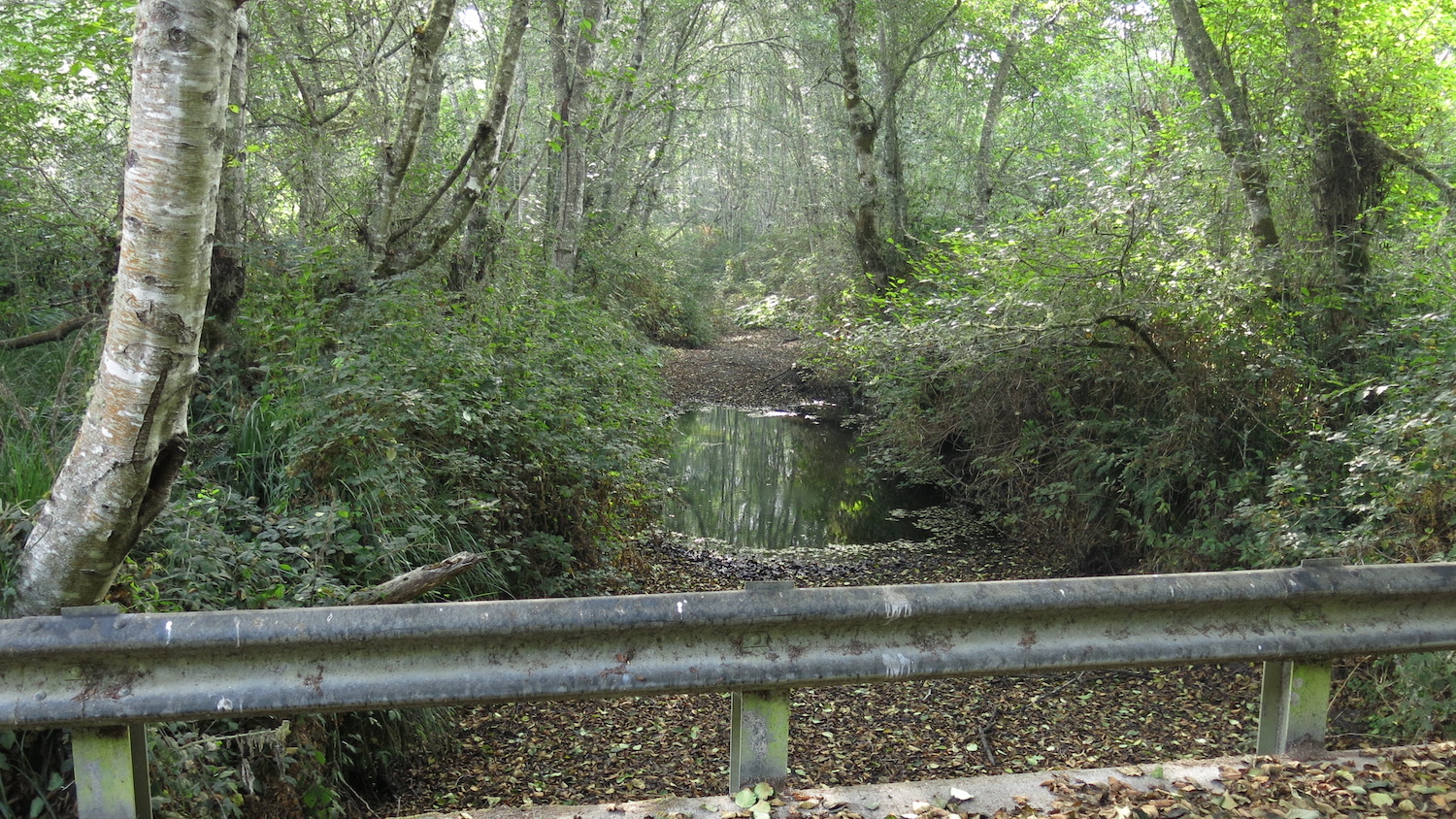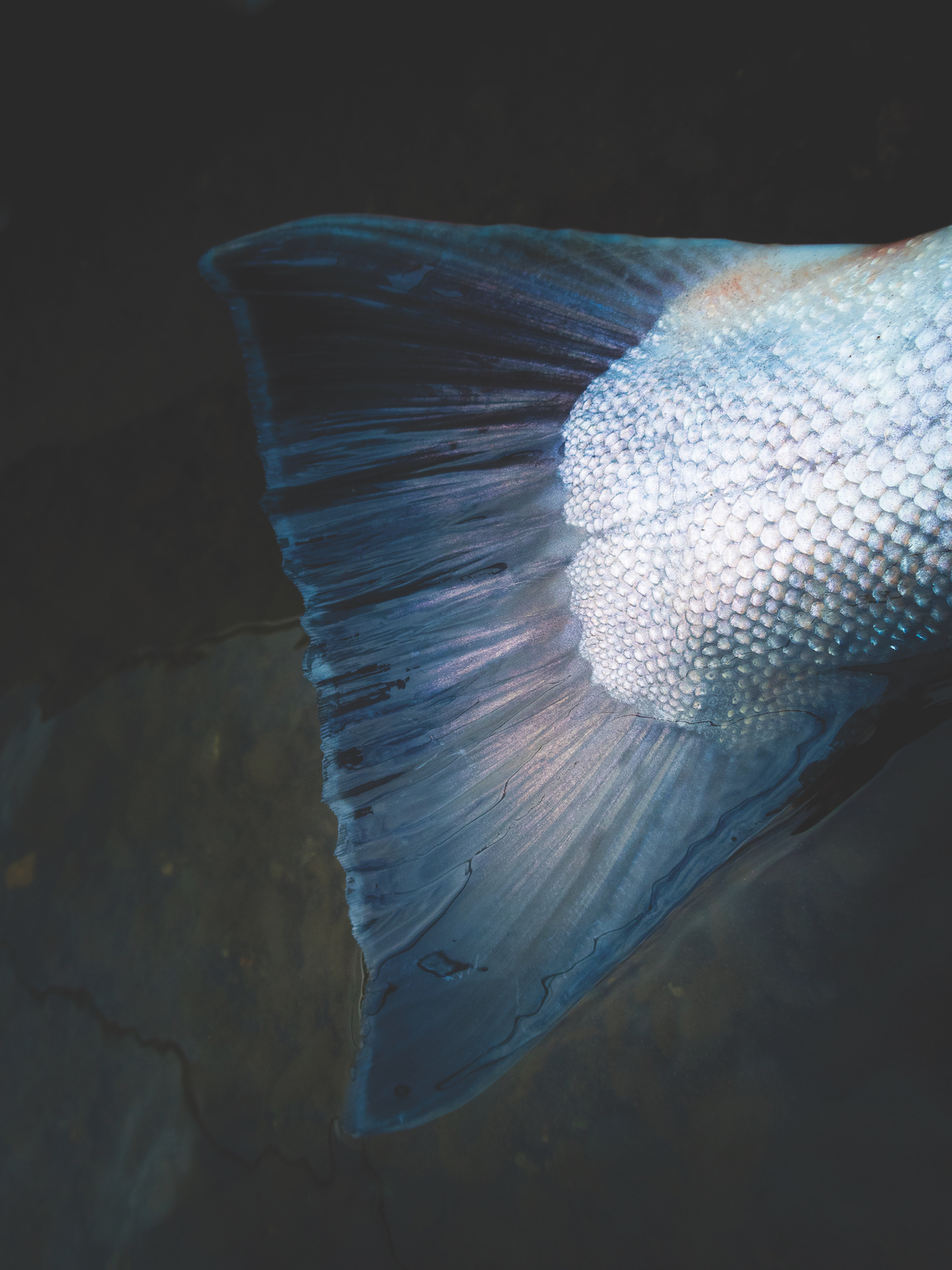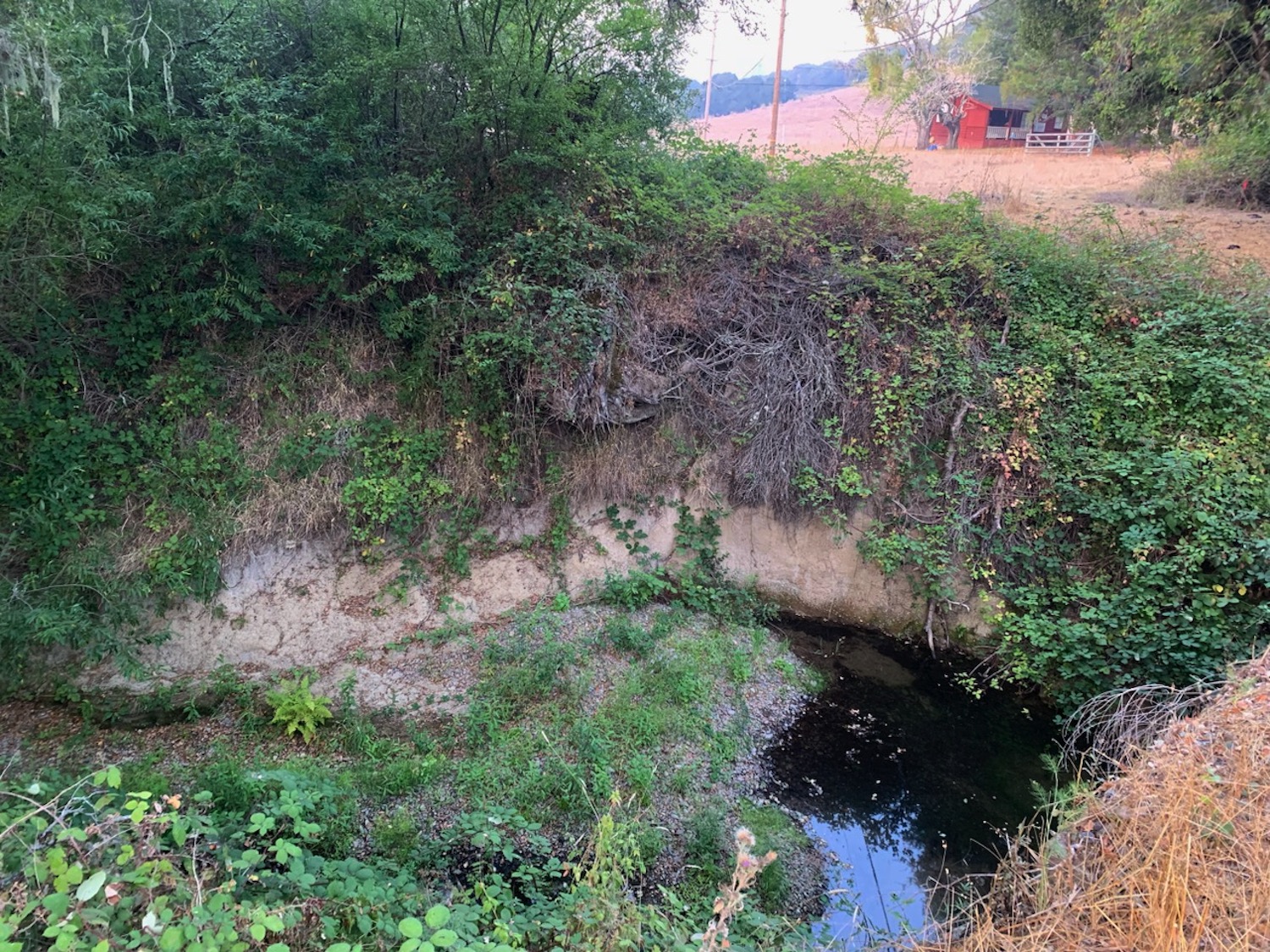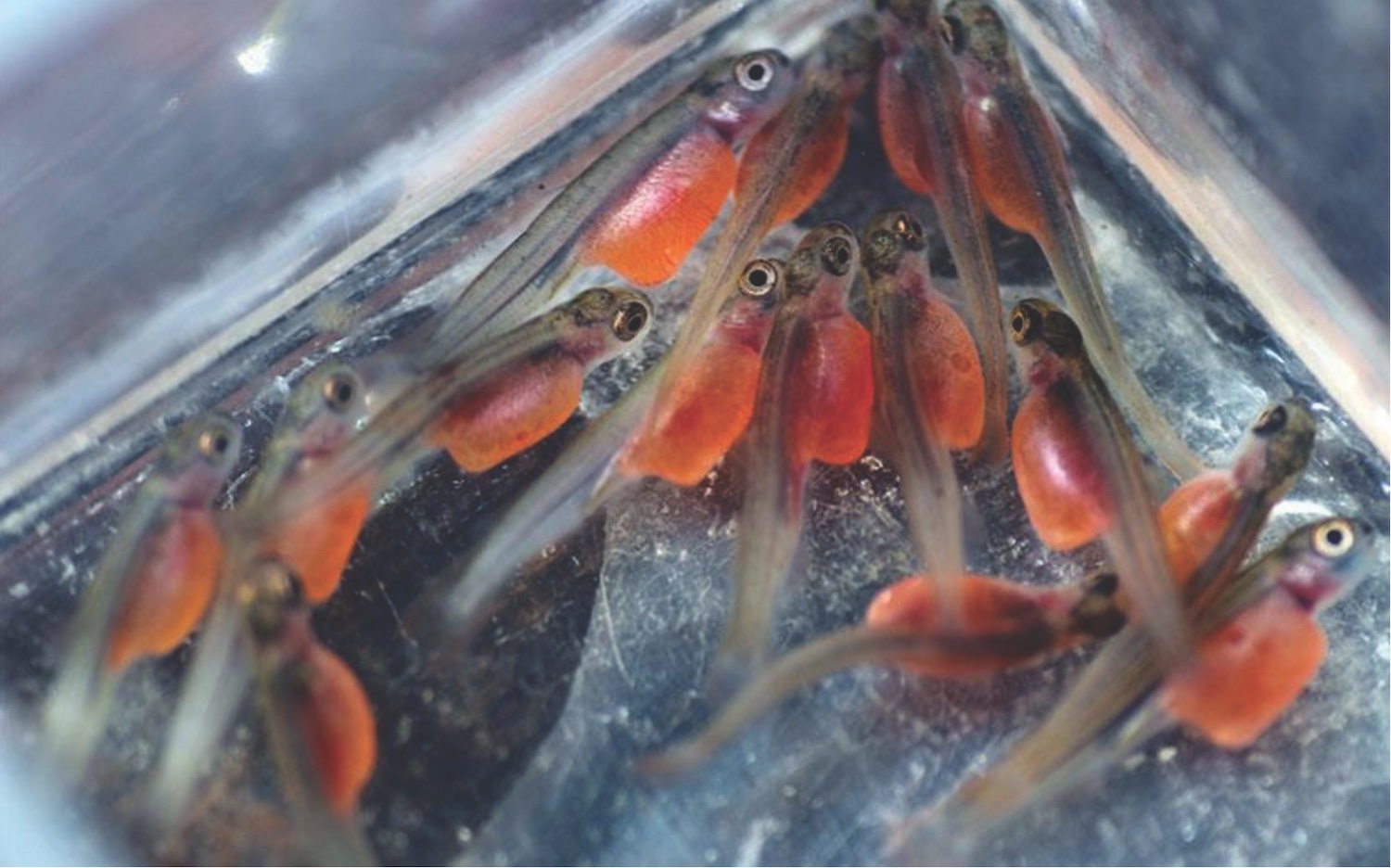This article has been conserved for you by Sonoma Land Trust.
The lazy waters of Willow Creek flow under a small highway bridge just a few yards upstream of its entry into the lower Russian River in western Sonoma County. The stream, about 30 feet across, is glassy and clear. Ducks paddle along the edges, and deer frequent the banks. The adjacent meadows and forested slopes, as part of the California State Parks system, are protected, and they’re coveted by hikers, bikers, and campers. While many passersby likely see Willow Creek as a pristine recreational getaway, John Green sees a watershed in distress.
“Under natural conditions, there wouldn’t be one single-thread channel,” says Green, a fluvial geomorphologist and a lead scientist with the Gold Ridge Resource Conservation District (RCD). Plotting a retrofit, he waves his hand over this imagined floodplain—where high winter flows would naturally spill outward, creating rich wetlands and prime foraging grounds for small fish. “It would probably be a narrower channel that was not as deep,” he says, “and there would be all kinds of tributary channels coming in, and there would be areas that got inundated more frequently.”

Willow Creek is at least half a century past its prime. Its six-odd miles have been ravaged by upland logging and lowland homesteading. Gravel and sand, washed from clear-cut scars, continue to smother parts of the system, making fish passage almost impossible. Here, at the mouth, dredging of the creek channel has lowered its elevation by several feet, just enough to cut the water off from reaching its intended floodplain. In fact, Willow Creek was once a prolific salmon stream but today, in its current form, is nearly fishless.
The same story can be told of most tributaries of the 110-mile Russian River, in which a long history of watershed abuse, including logging of old-growth redwood forests, has stripped the system of its fish habitat and sent anadromous salmonid numbers careening toward zero. The Russian’s once-abundant chinook salmon and steelhead trout have dwindled, but its coho salmon, especially, are in trouble. Untold tens of thousands historically returned to spawn each year in the Russian, which was a regional stronghold of the species. But by early this century, coho spawning runs had nose-dived to just two adults. Still on the brink of local extinction, the coho is dangling by a thread throughout its Central California range, where it’s federally listed as endangered. In the Russian, coho are kept alive with the aid of a fish hatchery.
Extinction would appear imminent except for a fresh flurry of interest in saving the salmon, with the Gold Ridge RCD at the front of the push. This quasi-governmental office, based in the rural outskirts of Sebastopol and serving Sonoma County, has received $8.4 million in federal money from the Bipartisan Infrastructure Law to begin undoing some of the impacts of roads, farms, and logging along two key tributaries to the Russian River. The funding comes as part of $491 million now being doled out over the next five years to marine and aquatic habitat-restoration projects around the country. The National Oceanic and Atmospheric Administration (NOAA) Office of Habitat Conservation’s Restoration Center is handling these grants. Among the funded projects are a catalog of initiatives, from Santa Cruz to Humboldt Counties, aimed at reviving coho salmon and steelhead habitat.
The Russian River work is focused on eight sites in Willow Creek, which enters the larger river about two and a half miles upstream from the Pacific Ocean, and Green Valley Creek, which meets the Russian near the town of Forestville. While these and other tributaries are not obstructed by dams—the classic death knell for a salmon run—other impacts have radically disrupted the way in which water courses through them. Much of their water is diverted for human uses. What water remains gets rerouted by roads, culverts, ditches, and levees so that, simply put, it no longer flows in the dynamic ways most beneficial for salmon and steelhead. Where rivers once tumbled down canyons studded with beaver dams, logjams, and deep eddying pools, they now race relatively unchecked to the sea, washing out the gravel where fish would normally spawn. At lower elevations, where gradients level out, sand and sediment have clogged many creek beds, creating dead-end channels that trap fish in sun-warmed water. In summer, many reaches of creek dwindle into chains of isolated pools, where salmon smolts are easily picked off by predators.
Green and his colleagues at the Gold Ridge RCD—along with two local environmental consulting firms, Prunuske Chatham and O’Connor Environmental—are considering measures that could mitigate these problems. They might, for instance, carve side channels and low terraces in adjacent meadows to facilitate seasonal flooding. Piling wood to imitate beaver dams is also on the table—a low-cost strategy that mimics the wetland-building work of the aquatic rodents, long ago eradicated from much of their range but considered fish-friendly watershed engineers. A year or more will pass before much of this work even begins, as the grant will largely support assessment and planning, but the hope is to start nudging the needle toward coho recovery.
“These sorts of projects are what is needed to move the species off of this path of extinction,” says Erin Seghesio, a fisheries biologist with NOAA who helped conduct technical reviews of grant proposals from organizations seeking federal restoration funds.
Ecologist Jacob Katz, a senior scientist with the group California Trout, believes the federal grant to the Gold Ridge RCD could enable the first steps on the long road to Russian River coho recovery. Doing so, he says, will require restoring “not a landscape but some approximation of the stream and river patterns that those coho need to provision each one of their life histories.”
Katz, who has spent more than a decade helping rebuild chinook salmon habitat in the Sacramento Valley, believes extinction is by no means locked in for coastal coho—just probable, he says, “unless current trends are changed, and this is what changing those current trends looks like.”
A watershed’s moment
At its northernmost reaches, in the mountains above Ukiah, the Russian River begins. Here, it touches fingers with the headwaters of the Eel River, which disappears to the north, into another troubled watershed of clear-cut scars and devastated salmon runs. The Russian gains volume as it flows south, fed by tributaries originating both east and west of the Highway 101 corridor. The river takes a sharp right turn just south of Healdsburg, flowing west past Forestville and Guerneville and finishing its journey to the ocean at the seaside town of Jenner. All told, the Russian drains 1,483 square miles of rugged terrain, including sunbaked oak woodlands and cool coastal slopes of conifers.
The river system flows through two major dams, creating Lake Mendocino and Lake Sonoma—key pieces of the region’s water supply. The Russian’s flows are even augmented by water piped through the coastal mountains from the Eel River, part of the controversial Potter Valley hydroelectric project. Hundreds of thousands of people in Mendocino, Sonoma, and Marin Counties consume the Russian River’s water. So do vast expanses of irrigated grapevines, which are sustained through the watershed. Its flows are severely impacted, especially in summer, and most of its floodplains have been eliminated by levees and elevated roadways.

It would be no surprise if salmon disappeared entirely from such an impacted watershed. Around the Northern Hemisphere, the fish vanished from most river systems once development, road building, and various extractive industries began to disrupt the ways in which water naturally flows, leaving the salmon abundant only in rivers of the far north, where the din of modern humans has not yet arrived. In fact, experts have warned that California’s salmon and trout are going down this road, with coho facing an especially poor outlook.
“Most or all populations [of Central California Coast coho] in small coastal streams will be extirpated from California in the next 50 years without increased intervention and protection of watersheds,” four scientists, including Katz, wrote in a 2017 report.
But the federal government, along with state partners, is getting serious about saving the fish. In 2012, the U.S. National Marine Fisheries Service (NMFS), a branch of NOAA, released a plan for coho recovery. The three-volume, 2,000-page document lays out a detailed road map for rebuilding coho habitat and undoing the severe impacts of coastal logging and development. Nearly 30 watersheds were assessed for recovery, with population-rebuilding goals mostly in the range of 250 to 3,000 spawning fish. The Russian River system is, by far, the most substantial, with a rebuilding goal of 10,100 adult coho. That would be just a fraction of historic fish returns but more than 60 times the 2022–‘23 winter’s spawner count. The report’s authors said coaxing coho back to abundance will require “embracing a paradigm that we can live, work, and use the land and water compatibly with the needs of the larger ecological community, including fish.”
That report continues to guide the way today as the feds throw tens of millions at Central California Coast coho recovery, which could eventually cost $1.5 billion over 50 to 100 years. While the funded projects have been carefully designed, the effort might still be seen as something of a Hail Mary, launched not when the coho crash was entering crisis mode but decades later, with the fish now 99 percent obliterated. Yes, rebuilding coho to abundance seems like a long shot, and even if we get there, well, we probably won’t, for the recovery deadline set by NMFS is almost 100 years away.
First stop: Willow Creek
The watershed of Willow Creek has dodged the fate of mountainsides and valleys farther to the east, which have been converted into grids of apple trees and irrigated grapevines. While the creek has been heavily disturbed, it’s very lightly developed: little of the system’s water is diverted for human uses, and there’s minimal infrastructure to get in the way of restoration work.
Also, Willow Creek enters the Russian very near the ocean, a bonus for salmon.
“If you’re a fish swimming up the Russian River and you’re looking for a good place to spawn, it’s close and easy,” Green says. By the same token, Willow Creek’s floodplains, if restored, potentially offer young fish ready to go to sea an almost direct drop-off into the ocean.
But in its current state, Willow Creek is not a friendly place for most fish. It’s been systematically disconnected from its floodplains by dredging, which benefited farmers of the last century by preventing inundation of their land. The floodplains are still there—acres of grassy meadows and willows adjacent to the creek—but the water, running over a lowered streambed, cannot readily reach them. A likely remedy is to lower the adjacent meadows, especially right along the creek, in what would be termed floodplain benches. Another option could be to deposit large woody material into the channel to slow and elevate the water. Either way, the goal is to allow more frequent and longer-lasting flooding.
Another problem area is just a short way upstream, along a one-mile section known as the stage-zero reach, now choked with sand and gravel washed out from upstream logging scars. This has created a migration barrier, turning the stream into a vague network of shallow or even subsurface channels that are just about impossible for fish to safely swim through.

“You have these reaches where there’s not really dominant channels, and fish that are trying to migrate out in the spring, when the flows aren’t that high, they go down the wrong lane. They end up in a dead end,” Green explains.
This problem is worsening—“working its way upstream,” Green says—as erosion continues. But there’s a solution: At present, several prominent sections of old creek channel, some essentially dry, still remain in the alder thickets. By placing logs and felled trees in just the right spots, at just the right angles, Green hopes to concentrate surface flows and direct them such that they reconnect those dormant channels, which have already been mapped out using laser-based survey technology. This low-tech strategy could help create a free-flowing stream again.
At Green Valley Creek, vineyards and bottlenecks
For all the work that will go into restoring Willow Creek, most adult coho that enter the Russian River in the winter swim right past it, in search of other good places to spawn. The slow and meandering watershed of Green Valley Creek, which begins in the redwood hills west of Sebastopol and meets the south side of the Russian 20 miles from the ocean, offers some of the most extensive, if mostly nonfunctional, floodplain habitat in the Russian River system—a marshy waterway where abundant invertebrate life (bugs, as many scientists prefer to say) consistently produces the biggest and healthiest coho smolts, if only a few, in the entire Russian River basin. The trouble is, artificial berms and invasive blackberries make the floodplains difficult for fish to reach, and of those that do find their way onto these rich feeding grounds, many don’t find their way out again.
Derek Acomb, an environmental scientist with the California Department of Fish and Wildlife who has been involved in the restoration planning, calls Green Valley Creek “a real catalyst for local recovery,” with potential for full recovery. Of the Russian River’s 20-something tributaries that historically hosted coho, in fact, Green Valley was one of the longest-lasting holdouts for wild coho, before spawning runs bottomed out 20 years ago and a hatchery program was launched to save them.
“We consider it our strongest coho stream,” Acomb says.
What ails Green Valley Creek is a gauntlet of familiar survival bottlenecks throughout the watershed—dredged channels, incised streambeds, sediment plugs, poor water quality, and hopelessly lost salmon and steelhead. At the confluence of Green Valley Creek itself and its main tributary, Atascadero Creek, flows have become so stymied by an alluvial fan of sediment that the water stagnates into a sort of swamp. Here, dissolved oxygen, Green says, “drops to zero.”
“It’s a death trap for fish.”

It also blocks adults from accessing prime spawning grounds amid the redwoods a few miles farther upstream in several sub-tributaries to Atascadero, like Redwood, Jonive, and Sexton Creeks, according to Joe Pecharich, NOAA’s technical monitor for the funded projects in the Russian River basin and a close collaborator with Green’s office on the restoration. Pecharich says unplugging this sediment clog is “the signature project” in this tributary basin and “should open the doors for a lot of Atascadero Creek for coho.” Detailed plans are still preliminary, but the general idea is to bulldoze out the creek channel and expand the stream’s capacity upstream so that sediment loads move through the system rather than piling up and forming a barrier again. If everything goes well, Pecharich says, upward of 1,000 adult coho could spawn in the system.
“If that sediment plug is dealt with, it’s ‘sky’s the limit’ at Atascadero, because right now it’s really off-line as far as helping out coho,” Pecharich says.
The life of Coho in the Central Coast
Coho salmon do something unique among the state’s salmonids: They begin and end their lives in redwood forests, or close to them, anyway. Their geographic range in California, in fact, closely overlaps with that of the iconic trees—and of Douglas firs. This was no coincidence. These tall trees intercept fog and, when forests were healthier and people fewer, produced enough canopy drip and shade to keep streams cool and running all summer. Coho thrived in this ecosystem, targeting small or tiny forest streams for spawning and leaving the larger river systems, including the Sacramento and San Joaquin, to the chinook salmon, which piled into California’s rivers by the millions.
While this trait was once a fantastic advantage for the coho, giving them access to a multitude of coastal trickles unused by their heftier cousin, it has become the coho’s Achilles’ heel. These small streams have suffered disproportionately at the hands of modern humans. Construction of roads, bridges, and homes, often protected with stream-bank armoring, has caused a complex problem: Unable to meander and flood as they would naturally do, such restricted waterways carve out their own beds, deepening into incised channels that flood torrentially when it rains and, when summer comes, quickly drain out, shriveling into disconnected chains of sun-warmed pools. Heavy diversion of water to homes and farms aggravates this pattern. Because juvenile coho spend a full year or more in cold fresh water before venturing to sea, entire generations can die during these brief dry-outs. If this happens in just several consecutive summers, a watershed’s coho can go all but extinct.
California still sees relatively abundant returns of chinook salmon in part because the smolts of the most plentiful population, the Central Valley fall run, tend to exit the river system and swim to the ocean at just several months of age. As veteran UC Davis fish biologist Peter Moyle explains, the fall-run chinook “bails out of the Central Valley before it becomes too warm. The coho don’t have that option. They need streams that have permanent flows that are really cold all year round.”
In the Russian River watershed, such conditions scarcely exist anymore. Nearly all small tributaries partially dry out in most summers, and this problem is getting worse. Last summer, Green watched as a small spring feeding Willow Creek from a forested, north-facing slope disappeared during the third year of intense drought—the first time he’d seen that happen to that stream.
Mariska Obedzinski, an extension specialist with California Sea Grant who has been monitoring Russian River coho for nearly two decades, says that summer dry-out of small tributaries is creeping into spring—a change she has observed within her career. This threatens not only the fish born a month or two prior but also smolts from the previous winter, trapping them in the river system just as they’re ready to swim to the ocean.
“So, it’s really affecting multiple life stages,” she says.
So complex and so deeply embedded into coastal watersheds are the problems affecting California’s salmonids that even partial recovery could be very difficult for coho. Moyle, one of the authors of the 2017 report that warned of local extinction, expects that warming trends combined with the impacts of irreversible habitat loss—especially the destruction of old-growth forests—will squeeze coho northward from California, which lies at the southern edge of their range.
“As the climate warms, that southern end will naturally move north,” he says. Considering the region’s changing environment, Moyle expects that coho are only going to survive in California “under very, very careful management.”
Already, the Russian River’s dwindling coho had a very close brush with extinction. Just two adults returned to spawn in 2002, and for an entire decade—from 2000 to 2009—returns averaged just four to five fish. The Warm Springs Hatchery (also called the Don Clausen Fish Hatchery), at the base of the Lake Sonoma reservoir, can probably be credited with saving them. It began spawning coho and releasing juveniles in the early 2000s and helped draw the fish back from the brink, though not out of the woods. The latest 10-year average for annual adult returns to the Russian is 425 coho salmon, and last winter, on the heels of repeated drought years, disappointed scientists counted 165 adults.
Low flows are a clear and present danger for coho and it’s getting worse, but the Gold Ridge RCD’s proposed projects don’t directly address this issue. Don McEnhill, the executive director of the Healdsburg-based advocate group Russian Riverkeeper, says he endorses efforts to rebuild structural river habitat features, but he thinks the river’s water must be protected, too.
“The bottom line for resurrecting a salmon fishery is that we’ve actually got that water, and it’s actually cold, and there’s enough of it that it provides suitable habitat,” he says.
Other fishery advocates have a different view of the issue. They believe that low flow problems can be ameliorated if watershed functions are restored. For example, Pecharich points out that piling logs and other woody material into creek channels—as beavers would naturally have done—can generate a cascade of benefits, trapping sediment and gravel, which in effect elevates a stream’s bed and makes flooding over adjacent banks and meadows more frequent. These events saturate streamside soils, which subsequently leak water back into the stream and maintain flows.
Katz also believes reestablishing vital flow patterns can help bypass the problem “so that the coho’s evolutionary keys once again fit into the tumblers of the watershed’s lock.” That, he says, is “when we get to a watershed capable of producing fisheries biomass again, producing abundance again.” It’s not too late to revive the Russian River, he says, but real progress must be made soon.
“We don’t have time to dillydally,” he says.
Green, though, says success will take time.
“It took 150 years of poor management to get us where we are now,” he says. “We’re not going to fix it in a decade. This is a long-term process, and we’d better be in it for the long term.”
Support for this article was provided by the March Conservation Fund.





